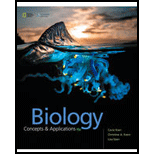
Concept explainers
A heterozygous individual has _______ for a trait being studied.
| a. the same allele on both homologous chromosomes |
| b. two different alleles of a gene |
| c. a haploid condition, in genetic terms |
Introduction:
Individuals in the population carry a specific set of alleles, known as genotype. The examples of genotype are homozygous and heterozygous. The phenotype of a plant depends on its genotype, and it is the trait of the individual that can be observed.
Answer to Problem 1SA
Correct answer:
Two different alleles of a gene are carried by a heterozygous individual for a trait being studied. Hence, the correct answer is option b.
Explanation of Solution
Reason for correct answer:
Option b. is given as “two different alleles of a gene.”
Locus represents the “location of a gene” on a chromosome. Individuals carry two copies of a gene because their cells are diploid and pairs of the chromosome are present in these cells. These double copies of any gene can be similar, or they can vary as alleles. If an individual carries two different alleles at a particular locus then its genotype would be called heterozygous.
Reason for incorrect answer:
Option a. is given as, “the same allele on both homologous chromosomes.”
If an individual has the same allele on both homologous chromosomes then the individual would be known as homozygous. Hence, option a. is incorrect.
Option c. is given as, “a haploid condition, in genetic terms.”
In individuals there are always two copies of genes are present. So, a heterozygous individual is a diploid condition, not a haploid condition. Hence, option c. is incorrect.
Hence, the options a. and c. are incorrect.
Therefore, the alleles of a gene on both homologous chromosomes would be different in a heterozygous individual. Thus, the correct option is b.
Want to see more full solutions like this?
Chapter 13 Solutions
BIOLOGY:CONCEPTS+APPL.(LOOSELEAF)
- Alleles for Tay-Sachs disease are inherited in an autosomal recessive pattern. Why would two parents with a normal phenotype have a child with Tay-Sachs? a. Both parents are homozygous for a Tay-Sachs allele. b. Both parents are heterozygous for a Tay-Sachs allele. c. New mutations gave rise to Tay-Sachs in the child. d. b or carrow_forwardWhen crossing two fruit flies with red eyes, which is a dominant trait, half of the male offspring are born with white eyes, but none of the females are. What is this an example of? A. an autosomal recessive trait B. an autosomal dominant trait C. an X-linked recessive trait D. an X-linked dominant traitarrow_forwardA man and his wife are both heterozygous for brown eyes. They have ix children all of whom have blue eyes? A) How is it explained? B) What are the chances that their next child will have brown eyes? C) What are the chances that their next child will have blue eyes.arrow_forward
- Why is there no trait (letter) on the y chromosome for males in this pedigree? A. Because the trait is X-linked (on the X chromosome) B. Because Ms. Premo made a mistake C. Because we never write anything on the y chromosomearrow_forwardTay–Sachs disease is caused by recessive alleles on anautosome. In which case(s) could two parents with anormal phenotype have a child with Tay–Sachs?a. Both parents are homozygous for a Tay–Sachs allele.b. Both parents are heterozygous for a Tay–Sachsallele.c. One parent is homozygous for a Tay–Sachs allele,and the other is heterozygous.arrow_forwardIn man, the allele for normal color (A) is dominant to the allele for albinism (a). A normal man whose father was albino married a normal woman whose mother was albino. a. What are the chances that their first child will be albino? b. What are the chances their second child will be albino?arrow_forward
- a human disease known as cystic fibrosis is inherited as a recessive trait.Two unaffected individuals have a first child with the disease. What isthe probability that their next two children will not have the disease?arrow_forwardMendel's pea plants were a good choice for studying heredity, because: a) They have lots of easily observable traits that vary in an either-or manner. b) Their mating is uncontrollable. c) There are separate male and female plants. d) The plants are incapable of cross-pollination.arrow_forwardGregor mendels experiments sought to discover if he could find the rules that govern A. Genetics B. Heredity C. Meiosis D. Mutationsarrow_forward
- is the term for a a person who has two different alleles at the same gene (locus) and both of these alleles are expressed. Group of choices (a)Recessiveness (b)Homozygosity (c)X-linkage (d)Codominantarrow_forwardif your phenotype is for a dominant trait, such as curly hair, then your genotype is? a: also for curly hairb: for both curly and straight hair c: a complex combination of all hair typesd: unknown, the alleles could be heterozygous or homozygousarrow_forwardIn an organism of genotype Aa, half the the gametes carry the A allele and half the a allele. this is due to: A dominance B recessiveness C independent assortment D segregationarrow_forward
